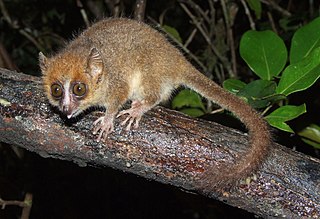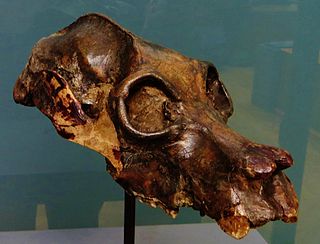Related Research Articles

Lemurs are wet-nosed primates of the superfamily Lemuroidea, divided into 8 families and consisting of 15 genera and around 100 existing species. They are endemic to the island of Madagascar. Most existing lemurs are small, have a pointed snout, large eyes, and a long tail. They chiefly live in trees and are active at night.

The ring-tailed lemur is a medium- to larger-sized strepsirrhine (wet-nosed) primate, and the most internationally-recognized lemur species, owing to its long, black-and-white, ringed tail. It belongs to Lemuridae, one of five lemur families, and is the only member of the Lemur genus. Like all lemurs, it is endemic to the island of Madagascar, where it is endangered. Known locally in Malagasy as maky or hira, it ranges from gallery forests to spiny scrub in the southern regions of the island. It is omnivorous, as well as the most adapted to living terrestrially of the extant lemurs.

The mongoose lemur is a small primate in the family Lemuridae, native to Madagascar and introduced to the Comoros Islands. These arboreal animals have pointed faces, long, bushy tails, dark-brown upper parts, pale bellies, and beards, which are reddish in males and white in females. They live in family groups and feed primarily on fruit, but also eat leaves, flowers, and nectar, with nectar from Ceiba pentandra trees making up a large part of their diet during the dry season. They have declined sharply in numbers because of habitat destruction and hunting, and the International Union for Conservation of Nature has rated their conservation status as "critically endangered".

Zoboomafoo is a live-action/animated children's television series that originally aired on PBS from January 25, 1999, to November 21, 2001. It was formerly shown in public television and was regularly shown on Sprout until 2012. A total of 65 episodes were aired. A creation of the Kratt Brothers, it features a four-(later five)-year-old talking lemur named Zoboomafoo, performed by Canadian puppeteer Gord Robertson, and mainly portrayed by a lemur named Jovian, along with a collection of returned animal guests.

Ankarana Special Reserve is a protected area in northern Madagascar created in 1956. It is a small, partially vegetated plateau composed of 150-million-year-old middle Jurassic limestone. With an average annual rainfall of about 2,000 millimetres (79 in), the underlying rocks have been eroded to produce caves and feed subterranean rivers—a karst topography. The rugged relief and the dense vegetation have helped protect the region from human intrusion.

The hairy-eared dwarf lemur, or hairy-eared mouse lemur, is one of the most scarcely known lemurs. A. trichotis is a nocturnal lemur that is endemic to Madagascar. It was originally named by Albert Günther in 1875 as Cheirogaleus trichotis as part of the Cheirogaleidae family, or the dwarf lemurs. In 1967 Petter-Rousseaux and Petter reassigned the lemur to its own genus and is the now only member of the genus Allocebus. The hairy-eared dwarf lemur was thought to be extinct until its rediscovery in 1989 in a northeastern primary lowland rainforest. The population of these mammals is shown to be severely decreasing and largely fragmented throughout Northern and Eastern Madagascar rainforests; most likely due to hunting, trapping, slash-and-burn agriculture as well as habitat fragmentation.

The mouse lemurs are nocturnal lemurs of the genus Microcebus. Like all lemurs, mouse lemurs are native to Madagascar.

The sloth lemurs (Palaeopropithecidae) comprise an extinct family of lemurs that includes four genera. The common name can be misleading, as members of Palaeopropithecidae were not closely related to sloths. This clade has been dubbed the ‘‘sloth lemurs’’ because of remarkable postcranial convergences with South American sloths. Despite postcranial similarities, the hands and feet show significant differences. Sloths possess long, curved claws, while sloth lemurs have short, flat nails on their distal phalanges like most primates.

Chamaesphecia empiformis is a moth of the family Sesiidae.

Pachylemur is an extinct, giant lemur most closely related to the ruffed lemurs of genus Varecia. Two species are known, Pachylemur insignis and Pachylemur jullyi, although there is some doubt as to whether or not they may actually be the same species. Pachylemur is sometimes referred to as the giant ruffed lemur, because although it and the living ruffed lemurs had similar teeth and skeletons, Pachylemur was more robust and as much as three to four times larger. DNA studies have confirmed a sister group relationship between these two types of lemur. Like living ruffed lemurs, Pachylemur specialized in eating fruit, and was therefore an important seed disperser, possibly for tree species with seeds too large for even ruffed lemurs to swallow. In the spiny thickets of southwestern Madagascar, they were also likely to have dispersed seeds evolved to attach to fur and be carried away. Unlike ruffed lemurs, the fore- and hindlimbs of Pachylemur were nearly the same length, and therefore it was likely to be a slow, deliberate climber. However, both used hindlimb suspension to reach fruit on small branches below them.

The Uni-Trade Stadium is a baseball stadium in Laredo, Texas. The stadium is the United States home to The Tecolotes de los Dos Laredos, a bi-national Mexican League professional baseball team, and the Laredo Roses, a women's full-contact American football team in the Sugar N Spice Football League. The stadium is also used for youth soccer leagues, youth and prep baseball games, and concerts. It was the home of the Laredo Lemurs, a baseball team in the American Association, from 2012 to 2016.
Psilocerea is a genus of moths in the family Geometridae described by Max Saalmüller in 1880.

Subfossil lemurs are lemurs from Madagascar that are represented by recent (subfossil) remains dating from nearly 26,000 years ago to approximately 560 years ago. They include both extant and extinct species, although the term more frequently refers to the extinct giant lemurs. The diversity of subfossil lemur communities was greater than that of present-day lemur communities, ranging to as high as 20 or more species per location, compared with 10 to 12 species today. Extinct species are estimated to have ranged in size from slightly over 10 kg (22 lb) to roughly 160 kg (350 lb). Even the subfossil remains of living species are larger and more robust than the skeletal remains of modern specimens. The subfossil sites found around most of the island demonstrate that most giant lemurs had wide distributions and that ranges of living species have contracted significantly since the arrival of humans.

Chamaesphecia is a genus of moths in the family Sesiidae.
Chamaesphecia seyrigi is a moth of the family Sesiidae. It is known from Madagascar.

The Laredo Lemurs were a professional baseball team based in Laredo, Texas, that played in the independent American Association from 2012 to 2016. The team played their home games at the Uni-Trade Stadium in Laredo, replacing the Laredo Broncos of United League Baseball. The team withdrew from the league prior to the start of the 2017 season.
Chamaesphecia doleriformis is a moth of the family Sesiidae. It is found in Italy, Austria, the Czech Republic, Slovakia, the Balkan Peninsula, Ukraine, Russia and Turkey.

Chamaesphecia masariformis is a moth of the family Sesiidae. It is found in south-eastern Europe, Turkey, northern Iran, the Middle East, the Caucasus, southern Russia, Uzbekistan and Tajikistan.
Eilema lemur is a moth of the subfamily Arctiinae found on Madagascar. It was described by Hervé de Toulgoët in 1954.

All Hail King Julien is an American animated streaming television series that stars King Julien, Maurice, and Mort from DreamWorks Animation's Madagascar franchise and takes place in Madagascar before the events of the first film, making it a prequel. It is the second DreamWorks Animation show to be based on the Madagascar franchise.
References
- ↑ De Prins, J. & De Prins, W. (2017). "Chamaesphecia lemur Le Cerf, 1957". Afromoths. Retrieved December 5, 2017.